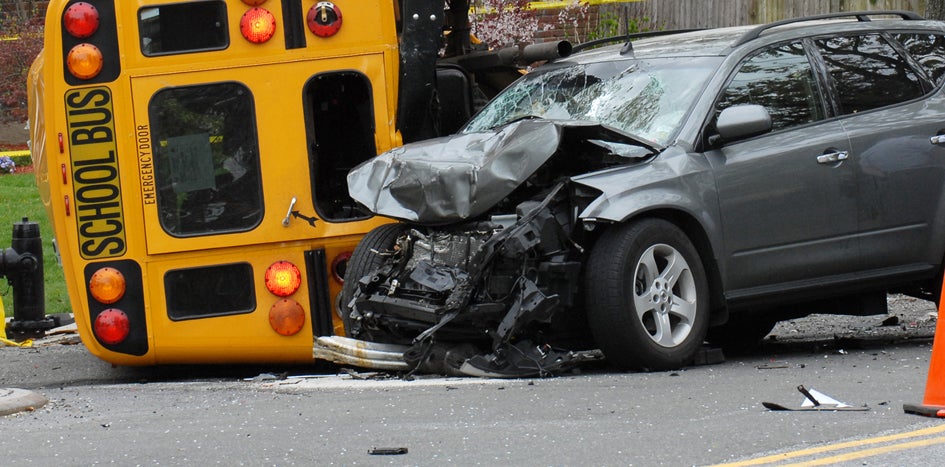Can This 200-Year-Old Invention Save Lives and Property?
Fire sprinkler systems sit unobtrusively above our heads in facility ceilings, so they’re easily overlooked. More than two centuries after the first system was patented, however, sprinklers are still saving property, equipment, and lives in schools across the country. Your systems can do the same if they are designed, installed, and maintained properly.
The case for fire sprinklers
A National Fire Protection Association study of fires over a four-year period makes a strong case for including fire sprinklers in your facility planning:
- The fatality rate registered 87 percent lower in properties with sprinklers than in properties with no automatic extinguishing system.
- The injury rate was 27 percent lower in properties with sprinklers.
- 96 percent of fires were confined to the room where they started.
- In 97 percent of fires in which one sprinkler operated, it was effective.
Sprinklers carry potential financial benefits, as well. Data from FM Global, a leading provider of commercial and industrial property insurance, shows the average fire loss in an un-sprinklered building is five times that of a fire in a sprinklered building.
How sprinklers work
You know those comedy scenes where someone holds a match near a fire sprinkler head and the entire system erupts? That’s usually not how it works. Fire sprinkler systems are powered by a network of pipes connected to a water source. When the temperature reaches a predetermined range, nearby sprinkler heads release water in an umbrella pattern.
Manufacturers offer a range of sprinkler systems designed to meet each facility’s unique needs.
- Wet pipe: Because the pipes are always filled with water, wet-pipe systems boast the fastest reaction times. For the same reason, they are also susceptible to freezing temperatures.
- Dry pipe: In a dry-pipe system, water is withheld until a sprinkler head is triggered. Dry-pipe systems are well suited to freezing temperatures. Because water is not immediately available, however, they do not react as quickly as wet-pipe systems.
- Pre-action: Like dry-pipe systems, pre-action system pipes are not constantly filled with water. Unlike dry-pipe systems, they require other conditions, beyond sprinkler head activation, to be met before water flows into the pipes. Pre-action systems are designed to reduce the risk of damage to water-sensitive property such as computer servers.
- Deluge: In a deluge system, all sprinkler heads simultaneously discharge water. Deluge systems are great for hazardous areas — and Hollywood comedies.
Fire sprinklers made simple
Fire sprinkler systems are like roofs, boilers, HVAC systems, and other facility components. They need to be installed and cared for by licensed contractors and trained staff. Follow these simple tips to ensure your sprinklers spring to action if a fire breaks out.
1. Know the regulations
Here is an overview of Texas fire sprinkler system regulations. This is not a comprehensive list, so members should consult their legal counsel for details:
- The Texas Department of Insurance adopted NFPA standards for fire sprinkler system installation, inspection, testing, and maintenance.
- Life Safety Code 101 requires new construction to include fire sprinkler systems.
- NFPA code requires schools to retrofit older buildings with fire sprinklers when performing certain construction projects.
- Texas law calls for schools to comply with local construction codes, which might mandate fire sprinkler systems. Even if local codes do not require sprinkler systems, the State encourages schools to provide them
2. Hire a licensed contractor
Fire sprinkler system designers consider the fire risk in each facility when planning a system. For example, you are more likely to experience serious fires in kitchens and science wings than in libraries and gymnasiums. Inadequate water volume or pressure are common causes of system failures, so designers also consider how much water would be necessary to address a blaze in the worst-case scenario. If a facility’s occupancy, construction materials, or other factors change after a system is installed, it might need to be enhanced.
Bottom line: Hire a licensed contractor to plan, install, inspect, and service your fire sprinklers.
3. Commit to routine maintenance
Like the sprinklers that keep lawns green in the summer, fire sprinkler system components can suffer damage. Pipes corrode, leak, or burst. Sprinkler heads clog or break. The law requires routine maintenance performed by licensed professionals. NFPA 25 sets the baseline for inspection, testing, and maintenance of water-based fire protection systems. Reference NFPA 25 and the manufacturer’s guidelines to ensure you keep up with requirements.
4. Lock control valves in open position
An NFPA study shows in three of five fires in which sprinklers did not engage, the system had been shut off. Too often, the fallout is devastating. FM Global recommends locking sprinkler valves in the open position except during maintenance, repairs, and other planned shutdowns.
5. Keep combustible materials off ceilings
It is not uncommon to find student art, holiday decorations, and other items hung from classroom ceilings. Depending on their design and location, as well as the size of the room, decorations can increase the risk of fires by blocking water from sprinkler heads. Life Safety Code 101 governs everything from facility lighting to emergency exits to warning systems. You are required to maintain at least 18 inches of clearance between stacked items and ceilings in rooms equipped with fire sprinklers. In rooms without sprinklers, the clearance requirement increases to 24 inches.
Protecting against burst pipes
Any conversation about burst pipes has to include extreme weather such as this year’s winter storm. Bitter cold temperatures wreaked havoc on school districts’ fire sprinkler systems and other plumbing. But temperature isn't the only risk you should monitor.
Year-round causes of burst pipes include corrosion, tree roots, and sudden water pressure increases.
NFPA 25 property owner requirements
NFPA 25 requires property owners to:
- Control temperatures:
- Keep water-filled piping no lower than 40 degrees Fahrenheit unless you're using an approved anti-freeze solution. Remember that the manufacturer has standards for how much solution should be in the pipes.
- Inspect system valves daily during cold weather to check for components that dipped below the minimum temperature. NFPA 13 Installation of Sprinkler Systems prohibits additives intended to stop leaks from being used in sprinkler systems.
- If fire sprinkler systems must be exposed to freezing temperatures, wrap them with insulation, and consider heat tape or cable to keep them warm. You should also evaluate modern security and fire alarm systems that allow you to monitor building conditions remotely.
- Keep dry pipe systems dry: Drain condensation regularly by opening drip pans.
- Use quality sprinkler heads: Do not reuse a removed sprinkler for any reason. If there are fewer than 300 sprinklers in the facility, store at least six new, approved sprinklers in a temperature-controlled cabinet on the premises. Increase that number to 12 spares if there are between 300 and 1,000 sprinklers, and at least 24 if there are over 1,000 sprinklers.
What if a pipe bursts?
Burst pipes are among the most common — and costly — claims filed by Fund members with Property coverage. Some losses can be softened if organizations respond quickly and appropriately:
- Verify the leak is coming from a sprinkler pipe: Otherwise, you might unnecessarily cut water to a critical safety system.
- Follow protocol before shutting down a system: If you discover a leak in a fire suppression system, shut the water supply off before having it repaired. Notify your alarm company and your local fire department before shutting the system down.
- Protect against fire: Stop hazardous fire activities and begin 24-hour fire watches in areas without active fire sprinklers.
- Preserve property: Remove high-value and water-sensitive equipment, and document damage.
With help from water remediators or plumbers
- Warm the pipes: If pipes are frozen, begin slowly heating them with warmed towels, hair dryers, and space heaters (if water doesn’t pose an electrocution risk), or other methods that don’t use open flames.
- Follow protocol before turning system back on: Again, notify your local fire department before turning the water back on. With leak spotters in the building, slowly return water to the system, and check for additional leaks.
- Open faucets partially: When you turn the water off in step three, you could introduce air into the pipes. Too much air build-up can affect water flow and cause pipes to burst again. By opening faucets, you allow air and sediment to escape. From there, you can replace damaged pipe insulation.
Fund members: Contact your risk solutions consultant for help navigating fire sprinkler compliance, installation, and maintenance best practices. We also encourage you to watch our recorded webinar, titled Prepare Your Facilities to Weather the Cold.

David Wylie
David Wylie serves as content developer on the risk solutions team. He brings more than 20 years' experience writing educational content that helps employers protect against workplace accidents, property damage, cybercrime, and other losses.
You May Also Like…
View All Related Insights
How To Manage and Mitigate Your Burn Risks
From bustling kitchens to science labs to maintenance and transportation shops, there are plenty of opportunities for burns to occur at your school or community college.

The Importance of a Thorough Accident Investigation
Conduct accident investigations to uncover the root causes of workplace injuries, correct them, and reduce the risk of similar injuries.

A Bird’s Eye View of Integrated Pest Management Compliance
State law requires schools to designate a trained integrated pest management (IPM) coordinator and implement an IPM program that includes these core elements.

8 Steps to a Preventative Maintenance Program
Preventative maintenance can save money for schools and minimize operational disruptions by extending the lifecycles of roofs, boilers, and other property.
